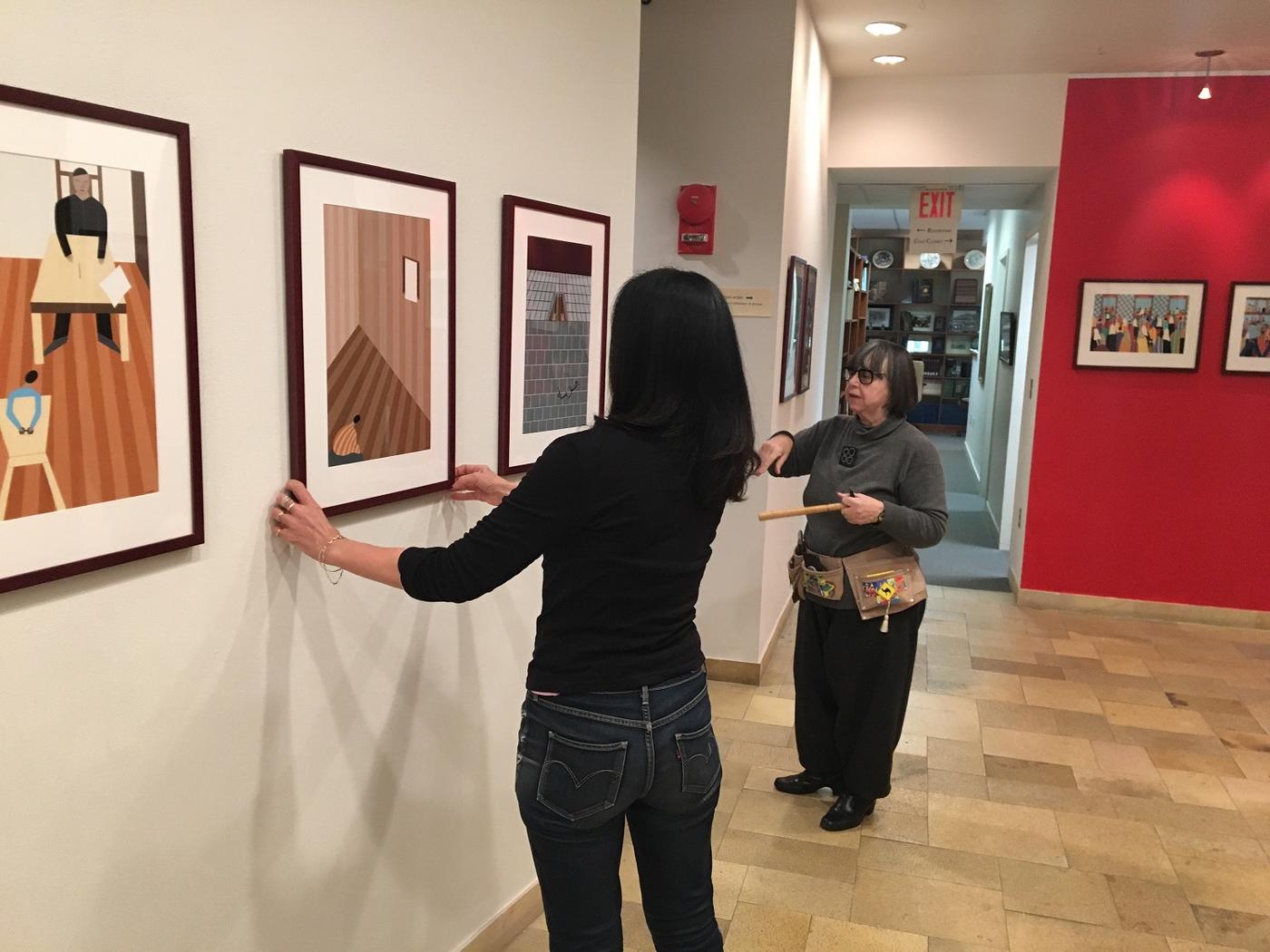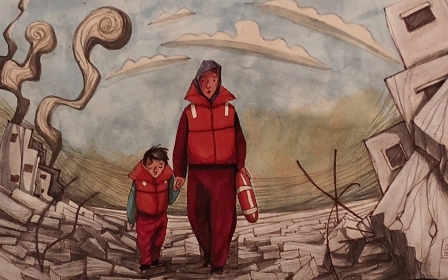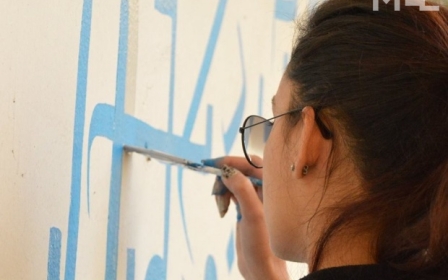Renowned Arab-American artist takes on Syrian crisis in newest exhibition
WASHINGTON - Helen Zughaib is easily one of the most well-known Arab-American artists in the world.
Her vibrant Middle Eastern designs can be viewed in collections all over the globe, including the White House, the World Bank and the Library of Congress.
The artist's work has also been gifted to world leaders by former US President Barack Obama, as well as former Secretary of State Hillary Clinton.
To the delight of Washington's art world, Zughaib's most recent exhibition, The Syrian Migration Series, opened on Friday evening for a five-week display in the capital's Gallery al-Quds.
New MEE newsletter: Jerusalem Dispatch
Sign up to get the latest insights and analysis on Israel-Palestine, alongside Turkey Unpacked and other MEE newsletters
Patrons squeezed through the gallery's wide hallways on the series' packed opening night, following the chronological path of pieces that displayed the story of the Syrian war and refugee crisis through the artist's talented eyes.
Zughaib's work is famous for her unique style, which often strives to portray the depths of human suffering in the Middle East through hopeful, vibrant colours and simple designs.
"Part of my objective in trying to get my message across is to create the work so that it's palatable to people," Zughaib explained to Middle East Eye.
"I don't want to disgust them, I don't want to horrify them. You know, there's a lot of stuff in [my series] that's very horrifying - if you know anything about the situation, it's brutal - but if someone comes in off the street and looks at these paintings, they'll be able to look at them without it being too much.
"At least I get them to the painting. Then they can do their own research once the interest is sparked - that's the goal," she said.
Zughaib took on the role of messenger between the Arab world and the Western one after the 9/11 attacks on the US. She was living in the country at the time and witnessed first-hand the rise of anti-Arab sentiment there.
'Dialogue between the East and West'
"I encountered a lot of negativity," she said, referring to the period after 9/11.
"Plus in the news the negative stereotyping of Arabs, of Arab-Americans, of course of Muslims - it was so rampant, and my work kind of began to try to say, 'wait a minute, we are going to tell our own story. Don't tell me who I am, and don’t speak for us'."
"I knew then I would start doing my own work to open this dialogue between the East and West."
'When we left Lebanon, my father said we were going away for only a week. I didn't get to go back for another 35 years'
- Helen Zughaib, artist
In her most recent series, Zughaib used the work of one of her heros, Jacob Lawrence, as a basis for each piece. Lawrence's works, put together under its title The Migration Series, documented the movement of nearly one million black Americans from the south of the US to the north between 1916 to 1930.
Many of Zughaib's pieces draw literal parallels between Lawrence's migration period and that of the Syrian people, while others are more distinctly abstract.
Like Lawrence's exhibition, under each of Zughaib's pieces in The Syrian Migration Series, a sentence or two is displayed explaining the next event in the Syrian crisis through her eyes.
Fleeing Lebanon
Zughaib, the daughter of a US mother and Lebanese father, does not take on the topic of forced migration from the outside looking in. The 60-year-old Lebanese-born artist moved back and forth due to conflict several times during her childhood.
The first time Zughaib fled Lebanon she was only eight years old. It was 1967 and the Arab-Israeli War had erupted.
She and her family returned not long after and continued life in Beirut until December 1975, eight months into the Lebanese civil war. Her family, all with their US passports, flew to France where Zughaib lived the next several years and finished high school.
She then moved to the US to study visual and performing arts at Syracuse University in New York.
"When we left Lebanon, my father said we were going away for only a week," she tells MEE. "I didn't get to go back for another 35 years."
Her words seemed to echo those of refugees throughout history, but she does not identify with the term, because she and her family were flown out by the US State Department.
The images of the day she last fled Lebanon are vivid, she said, as she described the masses of people on each side of the road leading to the airport all those years ago.
"I definitely identify with the idea of being forced to leave, but I do not consider myself a refugee in the sense that I had no choices, because I didn't have to go walk for miles and so on, in that kind of context," she said motioning to her artwork on the walls of the gallery depicting just that. "No, in that way I definitely am not."
When the so-called Arab Spring sparked in 2011, Zughaib was hopeful that those images of desperate people forced to leave home would no longer be a recycled reality in the Middle East.
"Along with the rest of the world, I was feeling happy that things were about to change a little bit in the Middle East, we all thought it was about to become a little more equal, a little more democratic," she said.
"Maybe I was naive on that, but I kept working visually to try and record what was going on, and then even as it devolved, I knew I had to continue, and I will keep continuing to tell that story until the story has been told."
Middle East Eye delivers independent and unrivalled coverage and analysis of the Middle East, North Africa and beyond. To learn more about republishing this content and the associated fees, please fill out this form. More about MEE can be found here.





